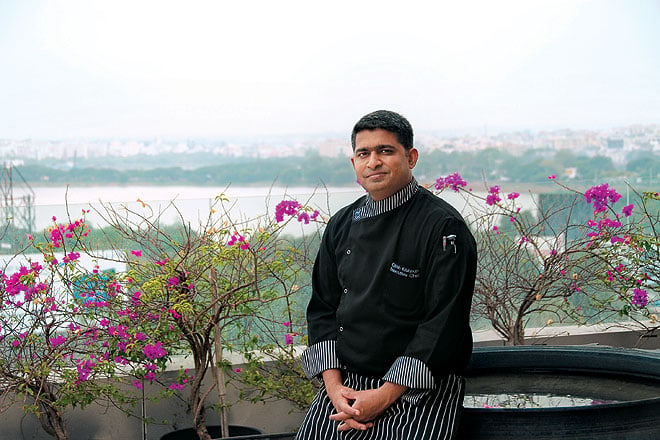OT: Why did you choose to become a chef?
Girish Krishnan: I started cooking as a
OT: Tell us more about ‘here’. The F&B seems elaborate at the JW Marriott Aerocity (Delhi) for an airport hotel…
Girish Krishnan: We are a big hotel, first, and hope to cater to large conventions. That our guests are coming in from the airport close by is convenient but secondary. So the in-room dining menu is curated to accommodate the sheer size of the hotel and features dishes that travel well the distance of the long corridors from the basement kitchen. We hope the guests will join us at the restaurants for our specialities, and we make sure to have a lot of choice in the buffets so that a guest staying with us for a week will have something new to try every day at K3 alone.
OT: Why ‘K3’?
Girish Krishnan: Well, we were lucky to have space for three kitchens! So to capitalise on them, we choose three cuisines. We also have three ovens, and that guided our choice. We decided to emphasise tandoor, pizza and duck oven techniques.First, then, we have Cantonese. Canton is the home of dim sum and Chinese herbal aromatics. So the food is very fragrant and flavourful. It is serendipity that chef Thomas Wee is from there. Then Tuscan, which is also tasty to Indian palates. Again, the chef heading this kitchen, Daniel Trivero, is from there. It is a colder region of Italy where vegetables are preserved over the winter. So Daniel brought in those techniques. His cooking style is also rustic on the one hand—like the tomatoes for his pasta sauce which he doesn’t blanch or peel or deseed, just uses straight—and on the other hand so very sophisticated technically. Finally, there had to be Indian and I wanted to keep it local—to Delhi, of the style of the Old City. Chef Asif’s family hails from Lucknow. So this kitchen does the authentic local style of biryani with sella or parboiled rice instead of basmati…harder to cook with but holds flavour so much better. We also focus on seasonal vegetables, and always have at least two dishes on the menu made up à la minute based on what’s good at the market. This offers the guest and the chef both freshness and variety. So the vegetable of the day could, yes, even be lauki…
OT: Your speciality restaurant Akira Back is an interesting study of exotic-meets-local (though not Indian!) flavour, isn’t it?
Girish Krishnan: Well, if K3 is about authenticity, Akira Back is about innovation and the intermingling of influences. Chef Akira Back is Korean himself and used to be a snow boarder. So, taking risks is not new to him. The cuisine here is contemporary Japanese, yes, but with Korean ingredients and techniques infused into it. So there is a robata grill in Korean style as one of his specialities, and there is a tuna pizza that you must try, and, yes, Chef had to create new vegetarian dishes for us Indians, and they are wonderful.
OT: It must be quite a job juggling this many tomatoes as Executive Chef! Do you have help and inputs from your peers across other Marriott properties?
Girish Krishnan: Indeed, Marriott has a chefs’ forum to exchange and feature ideas and best practices across global locations, with us all meeting once in six months in person and having webinars each month. The feedback and ideas are available to share with the kitchen teams on the walls in my basement office and they can access these on the employees’ network too.
OT: What’s your retirement plan? Back to the stove or as far as you can get?
Girish Krishnan: My ambition is to create and perfect six curries and four kebabs, to open a small restaurant of 20 covers… and go back to cooking with my own hands. Much as I enjoy myself running the show, I don’t get any time at the stove some days as the Executive Chef of a big hotel.


